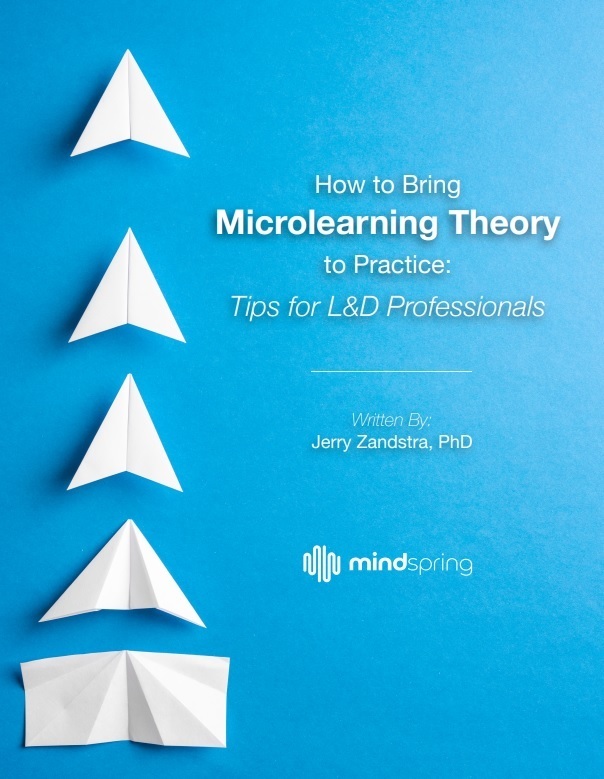When Should You Use Microlearning?
Microlearning isn’t a silver bullet. Although a popular method and a strong instructional strategy, it’s not always the best solution. We’ll begin with some circumstances in which microlearning may be the ideal option. Equally important, we’ll then consider some situations in which microlearning may not be the best choice.

Knowing when to and when not to begins with a thorough needs assessment that results in a strategic plan. Who are the learners? What are their needs? What’s your organization attempting to accomplish? What are your key metrics? What’s the experience and education level of your learners? What’s your current culture of learning? How’s your learning currently being delivered? Are you attempting to solve a problem? Prevent a problem? Create an opportunity? What will be the tone of the learning (fun, serious, scholarly, conversation, etc)? What technology is available to your learners?
The Solution You Might Be Looking For In 6 Examples
This is an incomplete list of questions, but it’s a good place to begin before you commit to microlearning—or any other type of learning. What follows are general guidelines for when microlearning might be just the solution you’re looking for.
1. When The Right Information Matters
Technology floods our world with information at our fingertips. Every trivia argument can be instantly resolved. Disagreements over statistics and facts end before they even get started. What a wonderful world! The difficulty is that some of the information available on the internet or even on Wikipedia isn’t correct. When a technique or process is mission-critical and precise information matters, share it via microlearning. Controlling information ensures that the right procedures and processes get conveyed.
2. For An Introduction Of Techniques
Microlearning is a great way to teach technical skills related to a very specific process. It does a good job answering the question, "How do I…?" Think of the team member who has little experience in a new role. Rather than overloading a new person with seven days of training and onboarding, figure out what they’re going to need to know and when they’re going to need to know it. Trying to quickly train to a complex system will likely not lead to sticky learning. Microlearning in a well-planned release might be just the thing.
3. As An Introduction And Reinforcement
When microlearning isn’t the appropriate mechanism, in the case of complex thoughts, actions, processes, and projects, it can certainly introduce a larger learning opportunity. Used creatively, microlearning can create dissonance prior to the main learning event by creating a scenario and leaving it unresolved for the moment. Microlearning can also reinforce what’s already been taught.
4. When It’s Actionable
When the learner needs immediate, specific information, microlearning might be the right solution. The main consideration might not be someone understanding an entire system. For a specific moment, learners may need to know how to replace something, grease something, enter data, or communicate up the chain.
5. For Smartphones And Tablets
When most or all learners have access to Smartphones or tablets, microlearning can be a great choice provided the other parameters apply.
6. When It’s Searchable
Learning in small, manageable bites works well only if it’s possible to quickly find the information the learner seeks. No one wants to search for a needle in a haystack or, worse yet, in a pile of other needles.
When Should You Avoid Microlearning?
Let’s take a look at situations in which microlearning might not be the best choice for learning organizations. The following are guidelines to be considered. They’re more akin to rules of thumb than to hard, fast, unbreakable rules.
1. For Complex, Interconnected Concepts
Learning content isn’t always simple, stand-alone, and bite-size. Sometimes what’s being conveyed is complex, because of what it’s challenging, and not easily grasped. Complexity can also be part of the equation when multiple ideas or concepts are tied to one another and the learning objective is to understand how the whole process works rather than the specific functions of individual parts. Gaps in systemic thinking can be serious and create a situation in which someone truly can’t see the forest but knows each tree. It’s possible to have mastery over a large number of unrelated concepts but miss how they fit and function together. There are even times when knowing in part but not the whole can be dangerous.
In some learning scenarios, learning by piece can frustrate participants. If they can’t see how the pieces fit together, they may even disregard learning about the pieces. This has to do with relevance. No one likes to learn facts that have little relevance to them. Learners can end up with a large number of information silos but no true knowledge, wisdom, or insight. It can be like trying to learn a new language by memorizing ten words a day—at some point, you might be able to cobble together a rough translation of a few sentences, but it’s unlikely you’d be able to speak the language because you wouldn’t know how it all fit together.
2. When Learning Requires Mastery
There are circumstances when learners need to master not only specific parts of a system and how they fit together but also require theoretical knowledge. These circumstances go beyond understanding a single system and require consideration of a series of systems and the science behind them. Some situations require substantial hands-on experience. For example, microlearning might not be the way to learn how to weld. That requires not just an understanding of the elements of the welding process and how they fit together. At some point, the deepest knowledge and expertise comes from standing next to a master welder for a series of days and learning from observation and correction of errors. The safety of others and the fledgling welder depends on the mastery of the process and skill.
Be wary of the thinking that everything can be learned in 3-minute chunks. Some things require more thought, more discussion, more examples, and more dissection. Start with a clarification of the audience, needs, abilities, objectives, and learning material. Use microlearning when it fits and choose other strategies when it doesn’t.
If you want to discover more about microlearning, download the eBook How To Bring Microlearning Theory To Practice: Tips For L&D Professionals. Get to discover all the enticing microlearning tips for L&D professionals. Also, join the webinar to discover how microlearning impacted employees' behavior and transformed organizational culture.


